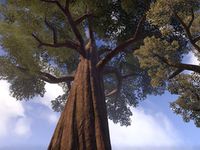- "Sprawling across both banks of the river stood the mighty graht-oak city, with groves and orchards of lesser trees crowding it like supplicants before their king. At a lesser scale, the tree that formed the moving city would have been extraordinary: gnarled and twisted with a gorgeous crown of gold and green, dripping with vines and shining with sap. At a mile tall and half as wide, it was the most magnificent thing Scotti had ever seen." — A Dance in Fire[1]
The graht-oaks are massive, ambulatory trees native to Valenwood. The Bosmer are known to build entire cities in the branches of these great trees, most famously Falinesti.[1] In their mighty boughs, Bosmer live alongside the ape-like Imga in a mobile ecosystem, coaxing the living wood into pathways winding around hide structures nestled in hollows.[2][3] The canopy of the trees is so large that it is sometimes called the second sky, or the middle green.[4] Emblematic of their reverence for nature, the Bosmeri Tower, Green-Sap, is represented in each and all of the graht-oaks, rather than in a single erected structure as with White-Gold and Ada-Mantia.[5]
The Elden Tree is an even larger subspecies of the graht-oak and one of the oldest living things in all of Tamriel. They are generally worshipped as focal points of the Green's essence. The cities, Elden Root and Falinesti are the only settlements built from the Elden Tree.[6][7] The southeast region of Grahtwood is known for its abundance of graht-oak trees, more than any other parts of Valenwood, hence its name.[8]
Known Graht-oak settlementsEdit
- Grahtwood
- Brackenleaf
- Cormount
- Elden Root
- Gil-Var-Delle
- Greenshade
- Shadows Crawl
- Whisper Grove
- Woodhearth
- Malabal Tor
- Silvenar
- Valeguard
- Vulkwasten
- Reaper's March
- Fort Grimwatch
- Vinedusk Village
- Unknown
- Falinesti
ReferencesEdit
- ^ a b A Dance in Fire, Chapter 2 — Waughin Jarth
- ^ The Red Kitchen Reader — Simocles Quo
- ^ Arboreal Architecture — Cirantille
- ^ Falicia's dialogue in Redguard
- ^ Aurbic Enigma 4: The Elden Tree — Beredalmo the Signifier
- ^ Elden Root loading screen text in ESO
- ^ Falinesti Autumn Site loading screen text in ESO
- ^ Grahtwood loading screen text in ESO
